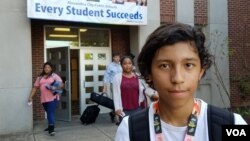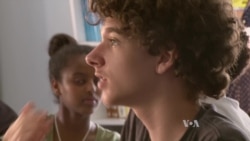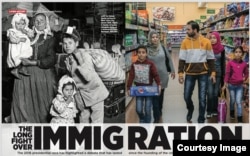In 20 years of teaching civics, Javaughn Perkins has never encountered a presidential race quite so fraught with educational hazards as the one now entering its final lap.
Among the pitfalls: racial and ethnic slurs, anti-Muslim talk, fat-shaming and name calling.
"A lot of the rhetoric, a lot of the ads that are out there tend to be focused in on issues that, as an instructor, I would not consider good for general conversation," says Perkins, in his classroom at the minority-majority George Washington Middle School in this suburb of Washington, D.C.
"I teach eighth-graders, who are image conscious," Perkins adds.
Some of them are taking the rhetoric personally. One student confided to Perkins that he was turned off when Trump, moving his arms spastically, seemingly mocked a reporter with a disability. The student is also disabled.
With students of all colors, creeds, ethnicities and sizes in his class, Perkins has tried to sidestep "all of the stuff that doesn’t matter: sensationalism of the candidates, the sound bites. What you really want to be teaching the kids is how to critically examine the issues."
In classrooms across the country, the presidential race is yielding disparate lessons. Some teachers have complained of a campaign "eliciting fear and anxiety among children of color, immigrants and Muslims" and giving license to crude language and threatening behavior, the rights group Southern Poverty Law Center said in a report it titled "The Trump Effect,” singling out Republican presidential nominee Donald Trump.
But educators also have found fertile new ground for civics exploration.
Perkins, for instance, is teaching about a historic first: a major political party has chosen a female nominee, Democrat Hillary Clinton. He’s also had students look at eligibility requirements for the presidency.
The research "gave us an opportunity to discuss what are some of the other expectations [for] our presidential candidates. We’ve looked at who has a law background, who has a political background," Perkins says. His students wondered whether the Constitution should be amended to require government experience.
Limited real-time learning opportunities
Because of the four-year U.S. presidential election cycle, teachers "have only about four opportunities at best while a child is in school, so they don’t want to miss this opportunity to teach the civics," says Stephanie Smith, an editorial director for Scholastic News, a national news and current events publication for students.
"We teach the civics, not the circus,” Smith emphasizes. “And if we need to get into the circus for kids who are a little bit older, we put it precisely on [their] level. And we make sure it’s accurate and balanced."
Scholastic’s teacher advisers, representing varied grade levels and communities, encourage tackling even difficult subjects. So, in covering the final presidential debate for fifth- and sixth-grade readers, Scholastic noted Trump’s apology for an 11-year-old video recording in which he "makes many highly offensive remarks about women.” It also cited the maelstrom over Clinton’s "handling of top-secret emails while she served as secretary of state," reporting that, "though the FBI determined that Clinton had broken no laws, it still called her behavior ‘extremely careless.’"
In past elections, "we’ve focused on education or the environment – issues that were bigger and that kids can connect with," Smith says. This time out, the publication has given more space to exploring, say, national security or immigration.
"We take care to say, ‘In this country, there are 50 million people who are immigrants, and 11 million of them are undocumented,'" Smith explains. "… We do very much care about the kids reading this who are immigrants or who are Muslim, not wanting to make them feel singled out. … We’ll alleviate fear and dispel some of the nasty rumors out there."
Homework for teachers
Jeremy Clabough, a University of Alabama assistant professor of social science education, once taught middle and high school civics and now trains others to do so.
"With this presidential election, with so many statements being thrown around, it’s important that teachers are spending more time doing their homework to get accurate information … giving an objective standpoint and setting up activities to let students reach their own classrooms," says Clabough, who's working on a book for the Association for Middle Level Education.
He talks about empowering students, going beyond rote memorization to "take information and process it and analyze it and then take civic action." That could mean volunteering for a campaign or attending town hall meetings or asking how to improve the community through public policies, he says. "It’s about analyzing positions."
Critiquing political ads
One recent afternoon back in Perkins’ classroom, nearly two dozen students cluster in small groups that he’s given inspirational labels such as Team Creativity and Team Honor. Their mission: to analyze the propaganda in political messages.
Perkins dips into an online archive of presidential campaign commercials from 1952.
One, from 1988, shows then-Vice President George H.W. Bush surrounded by his children and grandchildren, with a photo montage from his years in the military and public office. A 2000 ad for Republican nominee George W. Bush portrays him as “a compassionate, conservative leader.” A third, from 2008, has then-Senator Barack Obama, the Democratic nominee, talking about values he learned from his grandparents “straight from the Kansas heartland.”
When Perkins tells the class he’s going to show ads from the current presidential race, a collective groan arises. "Oh, God, no!" one student exhales.
But they listen quietly as an attack ad shows Clinton saying "it’s wrong to pit people against each other. ... I believe we are always stronger together." A later ad excerpts a Clinton speech in which she calls some Trump supporters "racist, sexist, homophobic, xenophobic." They’re "deplorables."
An ad for Trump shows steel workers who’ve "seen the jobs they love shipped miles" away. A narrator intones that, with America’s steel and American workers, "we’re going to make America great again for everyone."
Perkins asks students to compare the ads from past and present.
The older ones are "more positive and talking about all the good things" a candidate has "been doing and how he’s just so pure. ... Nowadays, it’s more like, you know, ‘He’s a pig,'" Alexandra Mkrtchyan says.
A male classmate observes a technical difference: "The video quality in the ’80s looks terrible."
But the earlier ads also have a different tenor. "In the '80s and '90s ones," another classmate says, "they were sort of more professional and [more current ones] are childish."
"They’re just bickering during the debate and it’s, like, not really saying anything," a classmate adds.
Arming with knowledge
After class, the teacher talks about the difficulty of getting adolescents to go beyond emotional responses to the candidates. It’s "hard for an eighth-grader to weed through all of that," he says.
Honors student Jonathan Zelaya, while waiting for a bus after school, credits Perkins’ class with giving him newfound knowledge and a sense of belonging.
Born in the United States to parents from Honduras and El Salvador, Jonathan has wavy dark hair and light brown skin. "Because of what I look like, a bunch of guys are coming up to tell me what’s going to happen to me" if Trump is elected, the 13-year-old acknowledges.
But civics class "is helping me learn what happened in the past" on issues such as U.S. immigration policy, Jonathan says. One of the first lessons he learned was that his U.S. birth automatically made him a citizen.
Perkins says he emphasizes the "current, real-world applications" of civics education.
"When students leave my class, I want them to have a sense of the world being bigger than them – and of their responsibility, when they see something that needs to be addressed, to have the empathy and also the skill set to address it."










